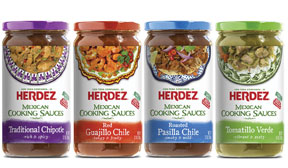 New flavors and formats are stirring the cooking sauce category, serving both a growing appetite for ethnic cuisine and the perennial push for more convenience in the kitchen.
New flavors and formats are stirring the cooking sauce category, serving both a growing appetite for ethnic cuisine and the perennial push for more convenience in the kitchen.As consumers discover global dishes in restaurants, they seek to simulate the experience at home, said David Turner, global food and drink analyst at Mintel International, a Chicago firm. Nearly one in five restaurant entrées contained an ethnic flavor last year, according to Mintel. With more than three-fourths of consumers claiming intermediate cooking skills, store-bought sauces have become a home chef’s helper.
“Consumers who aren’t the most confident in their cooking skills are not going to want to cook from scratch a cuisine they’re not 100% sure of, particularly if it’s an unusual cuisine to them, so they’re much more willing to use a cooking sauce or seasoning to help them along,” he said. “Particularly if you’re looking at Asian cuisine, some of those dishes can have seven, eight, nine individual ingredients if cooked from scratch. Not many people are going to have the time or the confidence in their skills to do that, so buying a premade marinade is a benefit.”
Several recent launches aim to satisfy the desire to whip up a worldly dish. The Campbell Soup Co.’s Skillet Sauces, which are added to meat or vegetables as they simmer on the stovetop, come in creamy chipotle, Thai green curry, Marsala and toasted sesame varieties. Campbell also plans to debut Slow Cooker Sauces later this year in four to five flavors, including Sweet Korean BBQ. ConAgra Foods Inc. last August began testing Hunt’s Dinner Sauces in Lexington, Ky., in Tuscan, Greek and Cacciatore flavors.
Authentic and traditional ingredients are becoming “increasingly important and a good way of adding value to the product,” Mr. Turner said. MegaMex Foods, a joint venture between Hormel Foods Corp. and Herdez Del Fuerte, in March introduced Herdez Mexican cooking sauces in four varieties designed to deliver flavors with just-add-meat convenience.
Busy, working families are most likely to use cooking sauces, according to Mintel, and new products promise one-step simplicity for busting a recipe rut. General Mills last year introduced Progresso Recipe Starters, shelf-stable dinner sauces in creamy Italian flavors. The product may be used as a foundation for hundreds of meal ideas, according to Progresso.
“The more the supplier can make the cooking sauce seem as if it’s proper cooking, the more people are willing to buy it,” Mr. Turner said. “If you can use your ingredient format almost in a more concentrated form like a jelly or solid that people then stir in themselves it makes them feel more like they’re cooking from scratch than a pre-made stock.”
Land O’Lakes Sauté Express, which debuted last year, are pre-measured, pre-seasoned blocks of butter and olive oil that consumers can toss in a pan with chicken, fish or pork. Another dairy-based dinner sauce comes from Kraft Foods’ Philadelphia Cream Cheese portfolio. Philadelphia Cooking Crème is spooned and blended into skillets, casseroles and pasta as a flavorful stand-in for condensed soup or sour cream.
The products appeal to a growing interest in chilled products.
“There’s a perception that if it’s in the chiller cabinet, it’s fresh and healthier,” Mr. Turner said. “As consumers migrate from more ambient and frozen products into fresh products, fresh cooking sauces and pasta sauces can grow particularly well.”
Consumers also are looking for products with fewer ingredients.
“Naturalness is a real opportunity because the barrier is people who are concerned about the number of ingredients,” Mr. Turner said. “Products with fewer ingredients and certainly ones that are additive- or preservative-free and MSG-free are real drivers.”
Low-sodium, low-sugar, and low- or nonfat products also may entice consumers, he added.
In spite of recent innovations and new flavors, most launches since 2009 were traditional, tomato-based sauces, according to Mintel.
“I think the opportunity for a lot of manufacturers is to add a fusion twist or an Asian flavor to it or to try to encourage consumers to be more experimental and try Asian sauces and flavors,” Mr. Turner said. “Tomato-based are doing well, but Asian foods are increasing.”





